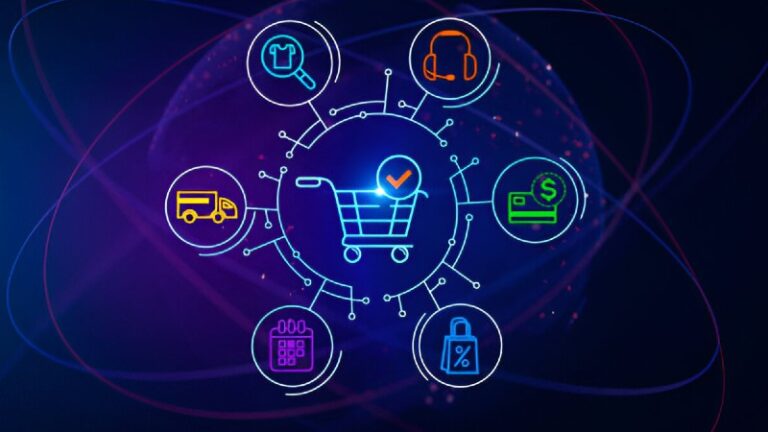The digital storefronts of today are undergoing a rapid metamorphosis, driven by evolving consumer expectations and groundbreaking technological advancements. What was once a transactional click-and-buy process is transforming into an immersive, tailor-made experience. If your e-commerce business feels like it’s navigating a crowded highway, understand that the roadmap to 2030 isn’t about simply adding more lanes, but about creating personalized express routes. The days of generic online shopping are behind us the future of e-commerce is undeniably shaped by hyper-personalization, dynamic live shopping, and the strategic embrace of niche markets. In a landscape where online sales are predicted to surpass $8 trillion by 2026, the question for brands isn’t if they should adapt, but how they can stand out.
Why the E-commerce Landscape Demands a Shift
The pandemic-fueled surge in online shopping has settled, and with it, a new equilibrium has emerged. Growth has stabilized, competition is fiercer than ever, and customers are no longer content with standard offerings. They expect brands to know them, to anticipate their needs, and to provide an experience that feels intuitively designed for them. Failure to deliver this level of understanding can result in immediate disengagement.
This isn’t just about meeting expectations it’s about competitive differentiation. Ninety-one percent of consumers are more likely to shop with brands that provide relevant offers and recommendations. Furthermore, nearly half of shoppers abandon a purchase if the experience feels impersonal. This stark reality underscores why a proactive embrace of personalization, live selling, and targeted niche strategies isn’t just an advantage it’s a fundamental requirement for sustained success.
The Bedrock of Tomorrow’s E-commerce
E-commerce personalization is the art of tailoring the entire shopping journey to individual customers based on their data. This goes far beyond simply addressing a customer by name it involves dynamic product recommendations, streamlined checkout flows, and content that resonates deeply with their preferences and behaviors.
The shift towards hyper-personalization is being fueled by advanced technologies:
- Generative AI: This isn’t just about analyzing data; it’s about creating uniquely tailored experiences. Imagine an AI that not only suggests a product but curates an entire outfit based on a customer’s style, location, and even local weather patterns. Generative AI can produce personalized emails, dynamic product descriptions, and social media ads at scale, effectively acting as a 24/7 creative team. Chatbots, too, are evolving, moving beyond FAQs to become virtual shopping assistants, offering real-time discounts or upsell suggestions.
- Image Recognition: Visuals are paramount in e-commerce. Image recognition technology analyzes the colors, patterns, and styles in images a customer interacts with, then triggers recommendations for complementary or similar items. It’s akin to having a personal stylist who understands visual cues that a customer might not even articulate.
- Voice Commerce: As smart assistants become ubiquitous, voice commerce is transforming. Personalization here means a voice assistant not just reordering a favorite item but suggesting complementary products based on purchase history, or reminding customers about upcoming restocks. Optimizing product catalogs for voice search and integrating AI-powered conversational tools will be key.
- Data’s Evolution (Zero-Party and First-Party): With increasing privacy regulations, the focus is shifting from third-party data to data willingly shared by customers (zero-party data) and data collected directly by the brand (first-party data). This is a golden opportunity. Brands are using interactive quizzes, surveys, and preference selectors (often gamified) to gather zero-party data. This, combined with first-party data from loyalty programs and direct interactions, provides the foundation for hyper-accurate, trust-building personalization. Tools like Segment or Customer.io are crucial for centralizing and analyzing this data.
Impact of Personalization on Customer Experience
| Element | Traditional E-commerce | Personalized E-commerce |
| Product Discovery | Generic categories, broad search | AI-curated recommendations, predictive suggestions |
| Communication | Standardized emails, general ads | Tailored messages, dynamic content, individual offers |
| Customer Support | FAQ pages, manual chat | AI-powered chatbots, virtual assistants, proactive help |
| Shopping Experience | One-size-fits-all | Uniquely catered to individual preferences and needs |
| Checkout | Standardized flow | Streamlined, frictionless, anticipates needs |
By investing in personalization, brands not only boost conversions but also cultivate deeper customer loyalty. Shoppers who feel genuinely understood are more likely to spend more and remain loyal advocates.
Live Shopping
Live shopping, or live commerce, is rapidly transforming online retail by reintroducing the authentic human connection that traditional e-commerce often lacks. It combines real-time video broadcasting with instant purchasing capabilities, turning passive Browse into an engaging, interactive event. This concept, pioneered in China with platforms like Alibaba’s Taobao Live, has seen explosive global adoption, especially post-pandemic. For instance, P.Louise, a beauty brand, famously sold two products every second during a 12-hour TikTok live session.
Key Elements of Live Shopping Success
- Expert Hosts: Whether brand representatives, influencers, or celebrities, charismatic hosts bring products to life, answer questions spontaneously, and build rapport. The credibility of micro-influencers with highly engaged, niche audiences is particularly effective here.
- Real-Time Product Demonstrations: Viewers can see products in action, understand functionality, and get a feel for scale or texture something static images cannot convey.
- Interactive Live Chat: This is where the human element truly shines. Viewers ask questions, request closer looks, and engage with both the host and other shoppers, mimicking the experience of asking a shop assistant.
- Seamless Purchasing: Integrated checkout features allow one-click buying directly within the stream, eliminating friction and capitalizing on impulse.
- Exclusive Offers: Limited-time discounts, flash sales, or special bundles create urgency and reward live viewers, incentivizing immediate purchases.
- Community Engagement: Live sessions foster a shared experience, building a sense of community around the brand through comments, reactions, and host acknowledgments.
Platforms like TikTok Shop, Instagram Live Shopping, Amazon Live, and YouTube Live are rapidly becoming powerhouses in this space, integrating entertainment and commerce seamlessly. Nordstrom, for example, achieved an 18% conversion rate during a one-hour holiday gift guide livestream, significantly outperforming their standard online conversion rates.
The true power of live shopping in the future of e-commerce lies in its ability to generate significantly higher conversion rates (up to 30% versus traditional 2-3%) and lower return rates. When customers see products demonstrated in real-time and get immediate answers to their questions, their purchase expectations are more accurate, leading to fewer mismatches and returns.
Niche Markets
While personalization and live shopping enhance the experience for existing customers or broad audiences, the strategic focus on niche markets defines who those customers are and allows for unparalleled precision. In a saturated e-commerce landscape, attempting to be everything to everyone is a recipe for mediocrity. Instead, identifying and dominating a specific niche offers a clear pathway to brand loyalty and market leadership.
Why Niche Markets are Crucial for the Future of E-commerce
- Reduced Competition: By serving a highly specific audience, brands face less direct competition from large retailers.
- Higher Conversion Rates: When a product or service perfectly matches a niche need, the likelihood of conversion skyrockets.
- Stronger Brand Loyalty: Niche customers often feel a deep connection to brands that truly understand their unique pain points or passions. This fosters a loyal community.
- Cost-Effective Marketing: Marketing efforts can be hyper-targeted, reducing wasted ad spend and increasing ROI.
- Expert Positioning: Specializing in a niche allows a brand to become an authoritative expert in that specific domain, building trust and credibility.
Consider the rise of direct-to-consumer (DTC) brands that initially thrived by focusing on specific consumer segments from sustainable activewear for eco-conscious athletes to ergonomic desk accessories for remote workers. The future will see this trend intensify, with brands drilling down even further into micro-niches.
Intersecting Niche with Personalization and Live Shopping
This is where the magic happens. Imagine a brand specializing in vintage sci-fi movie posters (a niche). Through live shopping, they could host a weekly Rare Finds session, demonstrating the posters, discussing their history, and answering questions in real-time. Crucially, using personalization, they could send targeted notifications to collectors interested in a specific movie franchise or artist based on their past Browse and purchase history. This creates an exclusive, highly relevant, and engaging experience that a mass-market retailer could never replicate.
Implementing Your Future-Ready E-commerce Strategy
Integrating these powerful trends requires a strategic approach. Here’s how to begin:
- Define Your Niche (or Niches): Deeply understand your ideal customer. What are their specific needs, passions, and problems? Market research, customer surveys, and analyzing existing sales data can reveal opportunities.
- Invest in Data Infrastructure: To power personalization, you need robust systems for collecting, analyzing, and acting on zero-party and first-party data. This means a powerful CRM and potentially a Customer Data Platform (CDP).
- Pilot Live Shopping: Start small. Choose a platform popular with your target audience (e.g., TikTok for Gen Z, Instagram for fashion/beauty). Focus on authenticity over high production value initially. Experiment with hosts, product demonstrations, and interactive elements.
- Embrace AI Tools: Explore generative AI for content creation, AI-powered chatbots for customer service, and image recognition software for enhanced product discovery.
- Prioritize Seamless Experiences: Ensure your mobile experience is flawless, offer diverse payment options (including BNPL), and integrate online and offline channels (e.g., BOPIS).
- Build Trust and Transparency: With increased data use, strict adherence to privacy regulations (GDPR, CCPA) and transparent data policies are non-negotiable.
Challenges and What to Watch For
While the opportunities are vast, challenges persist. Brands must contend with:
- Rising Customer Expectations: The bar for good is constantly being raised.
- Supply Chain Resilience: Leveraging AI for predictive analytics will be key to navigating disruptions.
- Data Privacy & Cybersecurity: Robust measures are needed to protect sensitive customer information.
- Economic Uncertainty: Adapting pricing strategies and inventory management will be crucial.
- Technological Adoption Curve: Staying updated with rapid advancements in AI, AR/VR, and other emerging technologies requires continuous learning and investment.
The landscape will also see continued evolution in:
- Shoppable Video Expansion: Interactive elements becoming commonplace in all video content, not just live streams.
- User-Generated Commerce: Empowering everyday consumers to create shoppable content, leveraging authentic peer recommendations.
- Hybrid Experiences: Deeper integration between physical stores and online channels, blurring the lines of retail.
Conclusion
The future of e-commerce is not a distant concept it’s being built today through the convergence of personalization, live shopping, and a sharp focus on niche markets. Brands that recognize this shift and strategically integrate these elements will forge stronger customer relationships, boost conversions, and ultimately, lead the charge in the next era of online retail. By prioritizing the customer, embracing innovative technologies, and finding their unique voice within a specific market, businesses can unlock unparalleled growth and loyalty. The time to innovate, adapt, and personalize is now.
Frequently Asked Questions (FAQs)
What is the future of e-commerce?
The future of e-commerce is highly personalized, integrating advanced AI, immersive technologies like AR/VR, and dynamic live shopping experiences to create more engaging and tailored customer journeys.
Why is personalization crucial for online businesses?
Personalization is crucial because it meets high customer expectations, boosts engagement and conversion rates, fosters stronger brand loyalty, and provides a significant competitive edge in a crowded online market.
How does live shopping enhance the e-commerce experience?
Live shopping enhances the experience by reintroducing the human element, offering real-time product demonstrations, fostering direct interaction between hosts and viewers, and driving impulse purchases through exclusive offers and community engagement.
What role do niche markets play in future e-commerce strategies?
Niche markets allow businesses to reduce competition, achieve higher conversion rates, build stronger brand loyalty, and implement more cost-effective marketing by precisely targeting highly specific customer segments.
How does AI impact personalization in e-commerce?
AI significantly impacts personalization by enabling hyper-tailored product recommendations, generating custom content at scale, powering smarter chatbots and virtual assistants, and transforming data into actionable insights for unique customer experiences.
What are some key technologies driving e-commerce trends by 2030?
Key technologies include advanced AI and machine learning, augmented reality (AR) and virtual reality (VR), voice commerce, the Internet of Things (IoT), and blockchain for supply chain transparency and secure payments.
How can businesses start implementing personalization in their e-commerce strategy?
Businesses can begin by defining their target niche, investing in robust data infrastructure for first-party and zero-party data, piloting live shopping initiatives, and exploring AI tools for content and customer service.


